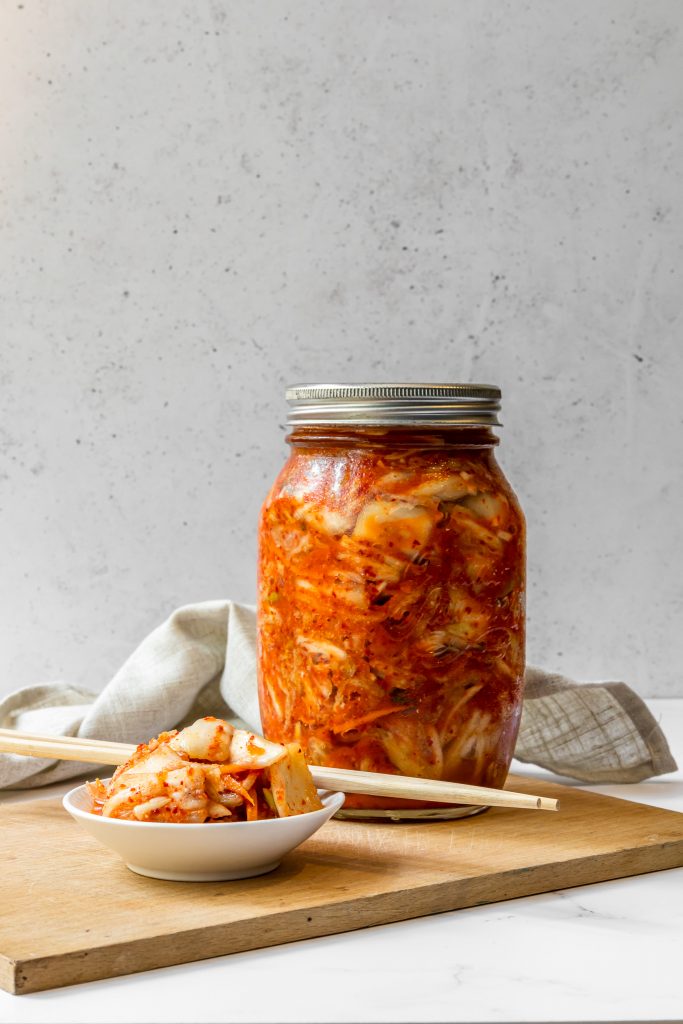Okay, cards on the table: I was never a fussy eater as a child, but when I first discovered that kimchi was fermented cabbage with lashings of chilli, I was pretty wary of it. With the start of the new year, it’s time to make a change! So I approached Seah Park and Ms Eunmee Shin, respective owner and chef at Korea Market in Cape Town, to pick their brains about this Korean condiment. Long story short: I’m a converted woman! Armed with a 200-year-old recipe that has been passed down for generations, follow along as they share their expertise and some pro tips to make kimchi at home.
View this post on Instagram
So what is kimchi?
Kimchi is a traditional Korean banchan (side dish) of salted and fermented vegetables flavoured with gochugaru (Korean chilli powder) and various aromatics. The most ubiquitous kind, baechu-kimchi, is made from Chinese napa cabbage, although there are many other interesting varieties out there including one made from oysters. An incredibly versatile condiment, kimchi can be enjoyed in many ways: in soups, stews, noodles and fritters, with eggs or, Seah’s favourite, in bibimbap. Don’t feel limited by its origins – the spiciness, tang and umami kick of kimchi can go with almost anything (yes, even mac & cheese!). Not sure know where to start? Try out these mouth-watering Korean short ribs with spicy kimchi cucumbers. My favourite way to enjoy kimchi thus far is simple: mixed into seasoned sticky rice and topped with a fried egg – YUM!
Kimchi gets its distinct sour profile from fermentation, a form of preservation that has been used for centuries. The process is driven by good-for-your-gut bacteria called lactobacilli which digest the sugars in the veggies to produce acid. This not only imparts a sour tang but also creates an inhospitable environment for harmful microorganisms. Lacto-fermentation is also used in the production of yoghurt and sourdough bread.
The process
There are four main steps when making kimchi: brining, seasoning, fermenting and storing. According to Seah, brining is the most important step in the whole process. Firstly, it encourages the growth of those friendly lactobacilli. Secondly, the salt helps the cabbage soak up all the flavours in the mixture. After brining, the cabbage is mixed into a tasty combo of gochugaru, fish sauce, ginger, garlic and onion, along with some other fresh veg. The kimchi is then left to ferment, and like ageing wine, becomes tastier and more complex with time. Kimchi should be stored in the fridge since the lactobacilli are more active at warmer temperatures – if left unchecked at room temperature, your container may explode or take on a lip-puckering level of sourness.
Make it yourself
After chatting to Seah, I couldn’t wait to make my own kimchi at home. Use the freshest ingredients you can find for the best results. Remember that kimchi is Korean soul food, so feel free to ad-lib the amounts in the seasoning mix. You can even add other ingredients such as salted fermented shrimp for extra funk. Have fun & enjoy the process!
Short on time? Find our super-quick kimchi recipe here
Baechu-kimchi
Ingredients
- 1 large napa cabbage (about 1.4kg)
- 2-3 tbsp table salt
- ⅔ cup water
- 4 tsp flour
- 2 tsp sugar
- ⅓ cup whole garlic cloves
- 2cm piece ginger, peeled and roughly chopped
- ½ onion, roughly chopped
- ¼ cup fish sauce
- ½ cup gochugaru (Korean chilli powder)
- 4 spring onions, sliced on the diagonal
- 1 small carrot, peeled and julienned
- ½ Korean radish, peeled and julienned (optional)
Instructions
Remove any outer leaves from the cabbage that have wilted or discoloured. Slice cabbage in quarters lengthways and remove the core; discard. Roughly chop cabbage into bite-sized pieces.
Wet cabbage leaves in cold water. Drain and layer in a large bowl with the salt.
Turn & press the cabbage every 30 minutes for 1 ½ hours or until the moisture is drawn out and the cabbage has softened but is still crunchy. Rinse and drain the cabbage three times in cold water to wash off all the salt. Place in a strainer and let any excess water drain for 15 minutes.
Meanwhile, place water and flour in a small pot and mix to combine. Stir over medium-high heat until thickened and bubbling, about 2 minutes. Add the sugar and cook for 2 more minutes until the mixture is translucent. Set aside until completely cool.
To prepare the seasoning paste, blend the garlic, ginger, onion and fish sauce in a food processor to a fine paste. Transfer to a bowl and stir in the chilli flakes and cooled flour mixture. Mix in the spring onions, carrot and radish.
Using gloved hands (highly recommended!), mix the drained cabbage into the seasoning paste, massaging and pressing down the mixture to help the cabbage to absorb all the flavours.
Place kimchi into an airtight container or sterile jar and leave at room temperature overnight to encourage fermentation, then store in the refrigerator. After 2 days, you may already see some bubbles forming and smell a slightly sour aroma. Kimchi can last up to 3 months in the fridge.
Notes
Increase the amount of gochugaru and fish sauce to taste.
SEE ALSO: The Ultimate Starter “101” guide



